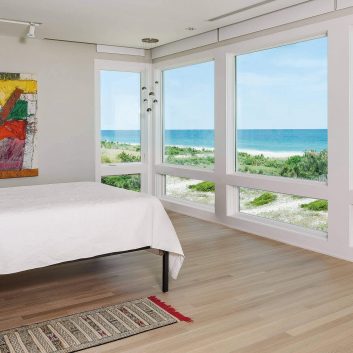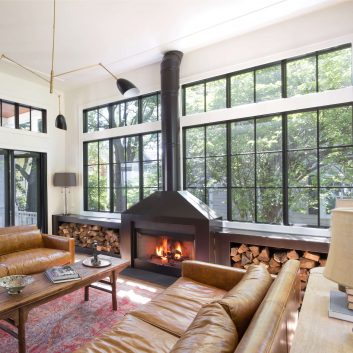Your Guide to Picture Windows
By: Architectural Visions
Selecting new windows for your home is an investment you may make only every 20 years, so navigating the world of windows may feel overwhelming. If you’re looking for a statement window, then a picture window may be the right fit for you. A well-placed picture window has the power to transform a space completely. A picture window is a window that doesn’t open or close. While they are designed with simplicity in mind, picture windows are made to bring natural light indoors, frame the outdoor landscape, bring the outdoors into your home, and let the natural scenery shine through.
Read on to learn everything you need to know about picture windows and to find out if it’s the best option for your space.
Key Takeaways:
- Picture windows are typically made from a large pane of glass that does not open or close, allowing for a lot of natural light
- Picture windows come in many shapes, including squares, circles, rectangles, triangles, and others.
- Picture windows can be paired with other windows, such as casement or double hung windows, to allow for extra light and ventilation.
What is a picture window?

Marvin Elevate picture window
A picture window is what its name implies – it acts as a picture frame to the outdoor scenery, giving you a clear view of your outdoor surroundings. A picture window doesn’t allow airflow or ventilation since it doesn’t open or close, but it is energy-efficient. In addition, picture windows allow ample natural light in the house since they are typically a large pane of glass.
Picture windows can be made in any shape: square, circle, rectangle, triangle, trapezoid, rhombus, or octagon. Multiple picture windows can be installed in the same wall, and often, they are joined with a narrow technique called mulling. As a result, picture windows can reach soaring sizes, with only structural considerations as limitations. Picture windows can even form an entire wall of glass.
If you’re looking to gain more natural light and expand your view of the outdoors, a picture window may be the perfect window for your space.
The history of picture windows
Historically, picture windows were only able to be made in small panes. These panes had a wooden framework, called muntin bars, to hold the panes together. Now, the glass can be made into larger pieces, and picture windows don’t need this traditional divider grid.
In the late 19th into the 20th century, newer styles of architecture such as Edwardian, Queen Anne, Prairie, Arts and Crafts, and Art Deco transformed the functional element of muntin bars into stylish patterns. Today, with brands such as Marvin, adding divided lights to a picture window is a highly customizable feature. Lines don’t need to be straight, and the sky’s the limit on picture window shape and size options.
Using a picture window
Picture windows offer endless versatility, as they can stand alone or be combined with other window types. While they can be any size, picture windows are typically larger scale to frame a large expanse of the outdoors. This scale makes them perfect for a living room or dining room.
Window combinations
 There are many combinations of windows to create a unique window design. Since picture windows do not open, pairing a picture window with other window styles provides the views that a picture window offers, combined with the function of operable windows. This may look like a picture window in the center to provide natural light, with casement windows or double-hung windows on each side for airflow and ventilation. You can also add an additional design element by adding a specialty window over your picture window to add extra interest and allow additional light to come in.
There are many combinations of windows to create a unique window design. Since picture windows do not open, pairing a picture window with other window styles provides the views that a picture window offers, combined with the function of operable windows. This may look like a picture window in the center to provide natural light, with casement windows or double-hung windows on each side for airflow and ventilation. You can also add an additional design element by adding a specialty window over your picture window to add extra interest and allow additional light to come in.
Illuminate the room
Bringing natural light inside the home can be a powerful way to transform both the interior, increase curb appeal, and serve as a mood booster. If you are looking to bring more light into a space or have a beautiful view outside, consider skipping the smaller windows and opt for a large picture window.
Complement other design elements
Picture windows are a great feature to use to fill unused space. They can completely open up a room or fill wall space that doesn’t receive enough light. For example, an enclosed living room with a single, double-hung window can feel like a new home by replacing that window with a large picture window. Or a picture window in a room with an angled ceiling brings in extra light to highlight the room’s extended height.
Installing a picture window
Installing a picture window requires a professional assessment, measurement, and installation. However, there are several factors to consider before you decide if installing a picture window is the best choice for your space. If you’re expanding your window, it’s essential to consider what is on the outside of the house since this requires you to expand the perimeter of your existing window frame. This may require you to cut into the exterior siding or brick.
Where to buy picture windows
If you are interested in learning more about picture windows or if this style will work well in your home, AVI can help. We are a premier window and door supplier in the Southeast with a full-service approach that involves helping you select the right door, handling the installation, and taking care of every detail in between.
Contact us to schedule a consultation or stop by one of our locations in Georgia, North Carolina, or Tennessee:

